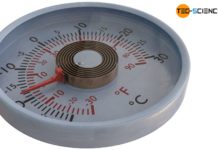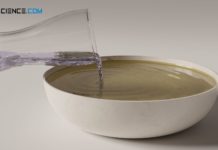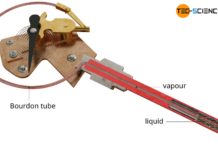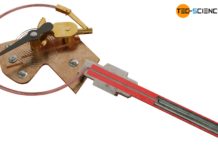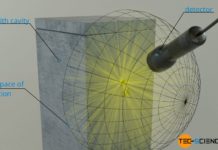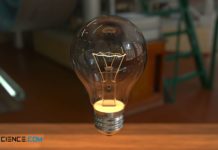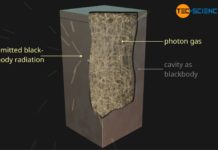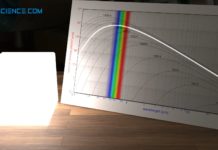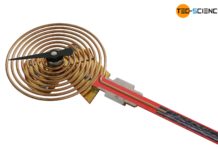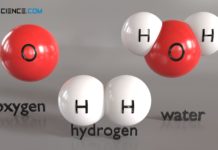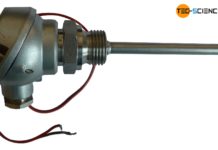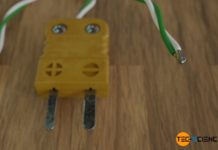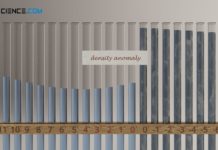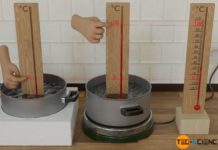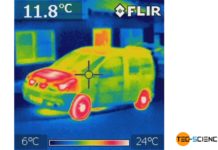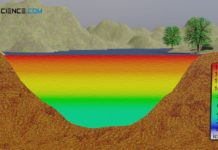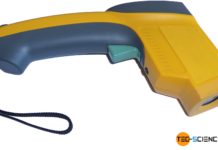How does a bimetallic strip thermometer work?
In bimetallic strip thermometers the different rates of expansion of metals when heated is used to measure the temperature!
https://youtu.be/RFWj7L05Yxo
Operating principle
Temperatures can be meassured based on the principle of different thermal expansion...
Final temperature of mixtures (Richmann’s law)
Richmann's law of mixtures describes the final temperature resulting in thermodynamic equilibrium when two bodies with different initial temperatures are brought into contact.
https://youtu.be/6tue9N7M1vU
Adiabatic mixing
If two bodies with different initial temperatures are...
How does a vapor pressure thermometer (vapor-in-metal) work?
Vapor pressure thermometers use the temperature-dependent vapor pressure of a liquid as the measuring principle.
https://youtu.be/K6HYsY6fF8k
The less popular vapour pressure thermometers work according to the same principle as liquid-in-metal thermometers or gas-in-metal...
How does a gas filled thermometer (gas-in-metal) work?
In gas thermometers, the pressure rise connected with a temperature increase is used for measuring the temperature!
https://youtu.be/aYpHDEhvzLo
In gas filled temperature gauges (also called gas thermometers or gas-in-metal thermometers), a gas is...
Why does water boil faster at high altitudes?
Due to the lower pressure, the boiling point of water decreases and the water boils earlier at high altitudes.
https://www.youtube.com/watch?v=-nf8w-SeFDM
Cooking on Mount Everest
With increasing altitude above sea level, the air pressure decreases...
Different forms of Planck’s law
Planck's law of radiation can be expressed in different forms. The most important ones are discussed in this article.
https://www.youtube.com/watch?v=JxDgEUsgAIs
Introduction
Planck's law of radiation describes the radiation emitted by black bodies. However, there...
Stefan-Boltzmann law & Kirchhoff’s law of thermal radiation
The Stefan-Boltzmann law states that the radiant power of an object in thermal equilibrium is proportional to the fourth power of temperature and directly proportional to its surface!
https://youtu.be/U67D8q88UDA
Introduction
In the article Blackbody...
Thermodynamic derivation of the Stefan-Boltzmann Law
In this article the Stefan-Boltzmann-Law is to be derived using the laws of thermodynamics.
https://www.youtube.com/watch?v=oo-A0uGeUlE
Introduction
In this article, the Stefan-Boltzmann Law is to be derived with the laws of thermodynamics. In order to...
Blackbody radiation
Blackbody radiation (cavity radiation) is the thermal radiation of a blackbody, i.e. a body that absorbs all incident radiation.
https://www.youtube.com/watch?v=Na-mFjyP8eU
Blackbody
When white light hits an opaque object, a certain part of that light...
How does a liquid filled thermometer (liquid-in-metal) work?
Liquid-in-metal thermometers use the pressure rise of a liquid that comes along with an increase in temperature, if the volume is kept constant!
https://youtu.be/Q7YNHcrrg2o
In liquid-in-metal thermometers (also referred to as liquid filled...
Particle model of matter
The particle model imagines matter made up of individual particles (atoms, molecules)!
https://www.youtube.com/watch?v=KBmhSd7wb5Y
The particle model of matter
The central model for the description of thermodynamic processes is the particle model, which will be...
How does a resistance temperature detector (resistance thermometer) work?
In resistance thermometers the dependence of the electrical resistance on the temperature is used to determine the temperature!
https://youtu.be/L5I8_AcJ_nE
Operating principle
A further measuring principle for determining the temperature is the change in the...
How does a thermocouple work?
In this article we will deal with the design and operation of a thermocouple which is used to measure temperatures.
https://youtu.be/y7efQiLkfkM
Seebeck effect
A thermocouple uses the phenomenon that a voltage is caused by...
Density anomaly of water (negative thermal expansion)
Density anomaly refers to the paradoxical behavior of a substance to expand suddenly when cooling down instead of contracting further (anomalous decrease in density).
https://youtu.be/tQ2JWasd0Yg
Negative thermal expansion (density anomaly)
Due to its special...
Temperature scales
Learn more about the origin of the Celsius, Fahrenheit, and Kelvin temperature scales in this article.
https://youtu.be/TDGU0kzHQyc
Introduction
In everyday life, temperature is often understood as a quantity that expresses the property of a...
How does a thermal imaging camera work?
Thermal imaging cameras are based on the same principle as the pyrometer. These cameras capture the radiation spectrum of an object, which then allows conclusions to be drawn about the temperature...
Why does ice form on the top of a lake?
Learn in this article why ice form always on top of a lake in winter.
The negative thermal expansion of water (density anomaly) has an existential importance for life on earth. More...
How does a infrared thermometer (pyrometer) work?
Pyrometers (infrared thermometers) use the heat radiation of objects invisible to the human eye to determine the temperature!
The thermometers presented in the previous articles must directly touch the object from which...

